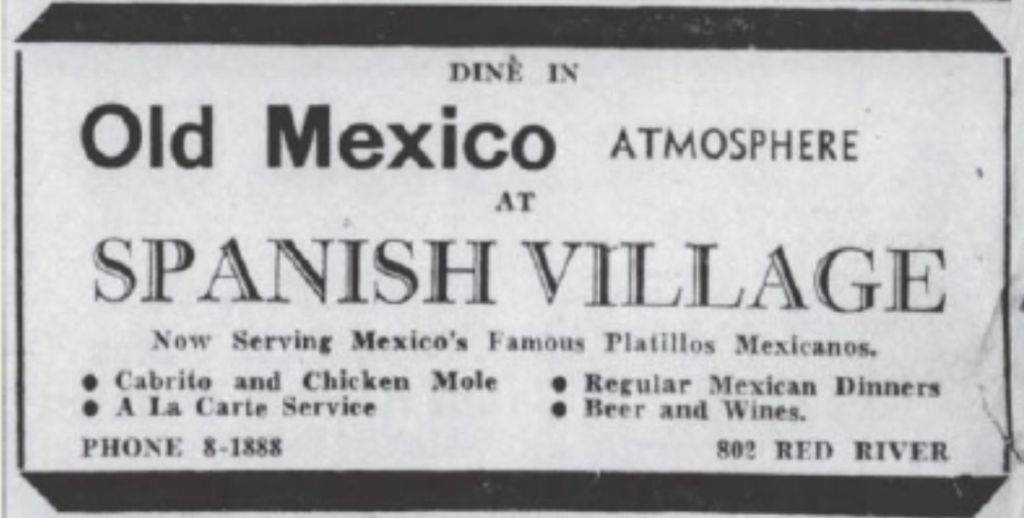Over the past month, we have seen Austin pay tribute to the many cultures and generations of Hispanic/Latinos who have shaped and enriched our country. As Hispanic Heritage Month comes to a close, we’d like to share several short stories that honor our local Latinx community.
At Waterloo Greenway, we recognize that our parks and Waller Creek are at the center of incredible Hispanic/Latino community history. The following stories were documented through a year-long research project in 2018, including Austin History Center archives, community leader oral histories, and in collaboration with local historians. You can read more stories of Waterloo Greenway’s past here — and, when Waterloo Park opens, you’ll be able to learn more about Austin’s rich history in person, at the park!
Waller Creek History
Spanish Village Restaurant

Restaurant. Source: Austin American‐Statesman.
The little house that became the Spanish Village Restaurant, and later Jaime’s Spanish Village, was built in 1915 and expanded in 1920. The restaurant opened at 802 Red River Street in the 1930s, and according to advertisements placed in the Austin American‐Statesman, they served “Mexico’s Famous Platillos Mexicanos” and offered an “old Mexico atmosphere.” Owners, Jaime and Teresa Tames became beloved neighborhood characters, known for helping out other recent immigrants. Their family story will be featured in signage at Waterloo Park.
The restaurant also catered to special events, including offering a 1939 Thanksgiving Day turkey luncheon and dinner, and entertaining Texas authors during the 1955 Writers Round‐Up. Its proximity to the University of Texas also meant it was a common gathering space for generations of sorority and fraternity members, university students, and their families.
Several other Mexican restaurants lined Red River Street in the 1940s, including La Fiesta and Old Mexico, but the Spanish Village Restaurant was the longest standing “Tex‐Mex” establishment. When Jaime Thames purchased the restaurant in the 1970s, he renamed it Jaime’s Spanish Village and decorated the walls with images of his past career as a bullfighter in Mexico. Jaime also filed for a patent on his self‐titled margarita, the “Margarita Jaime,” which was a frozen margarita with a sangria floater on top. His nephew Charlie Thames, who would go on to own the restaurant before its closure in 2010. The family continues their legacy, selling their original Jaime’s salsa in stores across Texas.
History of Palm School
On the corner of Cesar Chavez and the I-35 frontage road stands the old Palm School building, the current home of the Travis County Health and Human Services and Veteran Services building, but the building is best known as the elementary school that stood in service to many communities of color of East Austin for 84 years before closing in 1976. Palm School, founded in 1892, was one of the first elementary schools in Austin, and has long-standing ties to our Hispanic/Latino community. The school was the first public school in Austin to have a kindergarten class in 1917 and in 1923, Palm School was the largest elementary school in the city of Austin.
Austin City Council Member Pio Renteriá fondly recalls his days as an elementary‐age student at Palm School, which was enlarged in 1948 and 1949 to accommodate its growing enrollment. For Rentería, memories of free ice cream from Superior Dairies across the street are more pleasant to recall than those of having to watch swimmers outside the fence of the segregated Palm Park pool. Although the pool was available for some, children still swam in Waller Creek near Palm School and Park.
The school survived for a time, but, the construction of Interstate 35 cut the school off from the community it served. Then, when George I. Sanchez Elementary School opened on the east side of the highway in 1976, many students in that neighborhood attended the new school. After almost two decades of falling into disrepair, Palm School closed in 1976.
Slideshow images courtesy of the Austin History Center, Austin Public Library
Juárez‐Lincoln University
The Mexican American Youth Organization voted to establish a southern Texas Chicano university in 1969 in the midst of a movement for much-needed advancement of the Chicano community. Juárez‐Lincoln University was born and eventually moved into the vacant East Avenue Baptist Church. The university closed in 1979, and the building was sold in 1980. After community activists made several attempts to declare the property historic, the owners demolished it in 1983, strongly impacting our Mexican-American community.
Slideshow images courtesy of the Austin History Center, Austin Public Library
Mexican American Cultural Center
In the early 1970s, community members asked the City of Austin to establish a cultural facility honoring the Latino community and reflecting the historic Rainey Street neighborhood. After unsuccessful efforts in the late 1980s and 1990s, the Emma S. Barrientos Mexican American Cultural Center (MACC) finally came to life in June 2007, neighboring Waller Creek. Today, the MACC offers dozens of community programs and exhibits. For more information, visit their website.
MACC, Emma S. Barrientos Mexican American Cultural Center from Frazer Pogue Collective on Vimeo.